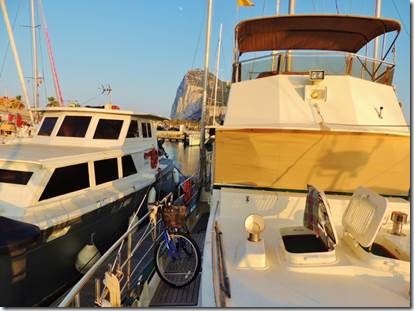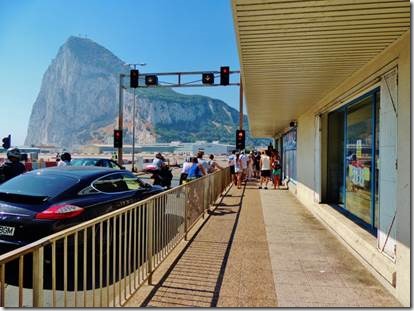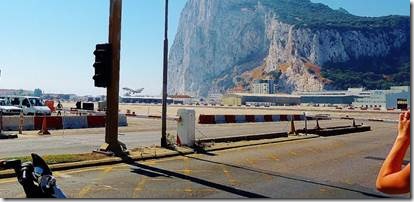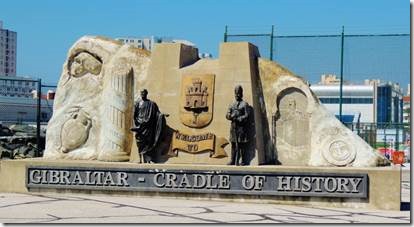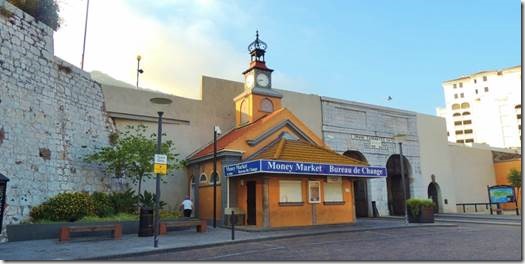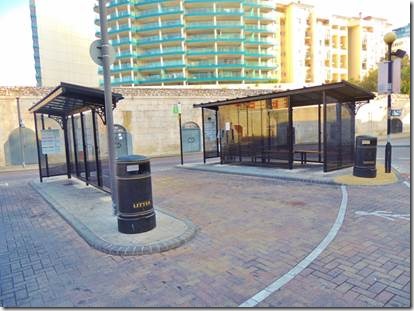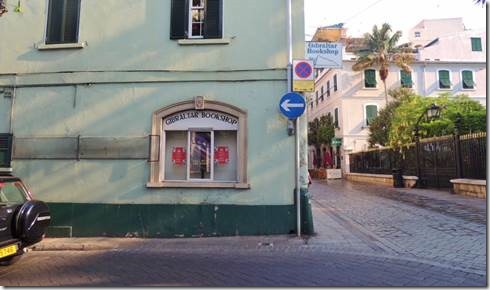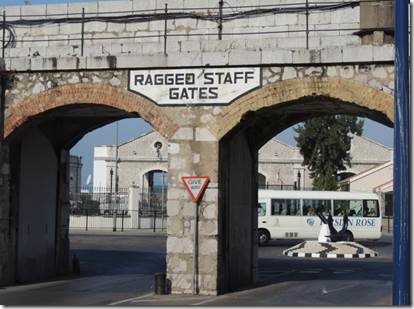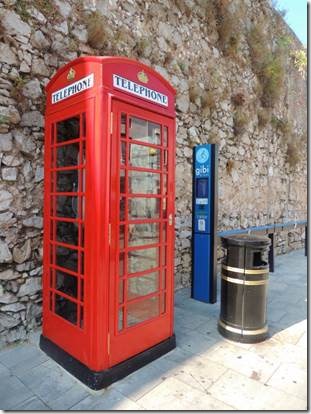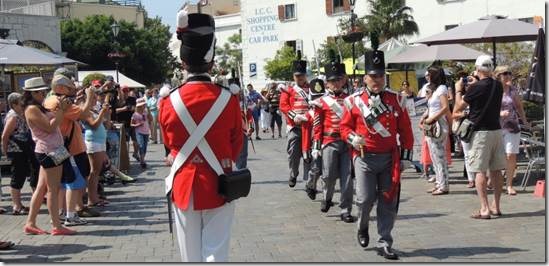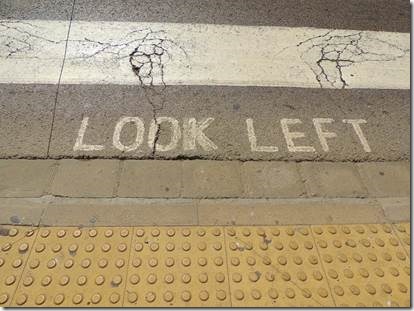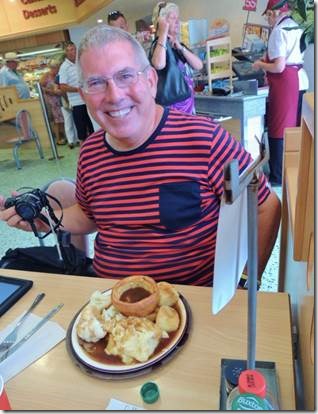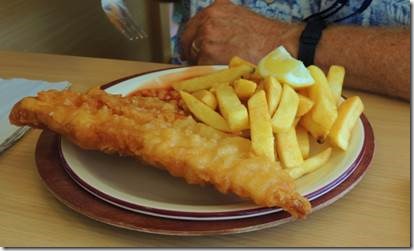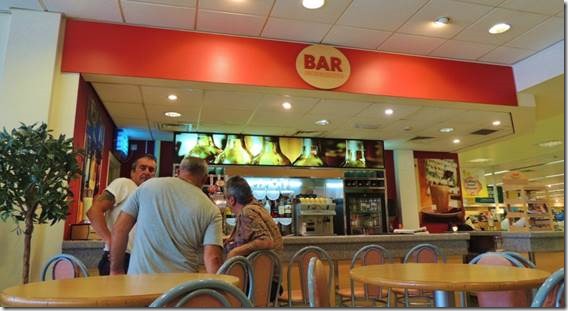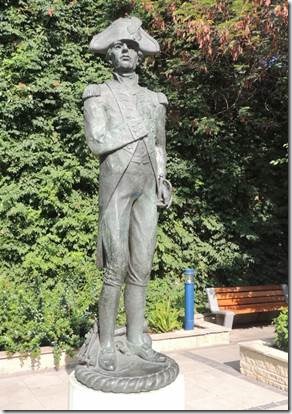Hola,
We left early this morning for a visit with Sue and Ed in Gibraltar. As a break from Tunisian mosaics I thought I’d write a bit about Gibraltar and then when I’ve more photos I’ll write about La Linea.
And eventually I’ll catch up with Tunisia.
Ru
The Rock of Gibraltar is the last thing we see at night and the first thing we see in the morning. Sometimes it’s shrouded in fog. Sometimes, as now at 7 pm it’s lit with bring sunlight. Late at night, and it has to be really late as sunset is 9:30 pm, the Rock is lit from below so its rock-face shines. One way or the other I hope we’ll get to the top before we leave. The views are said to be wonderful.
|
9 PM and bright and sunny still. Screws up my sleeping as it’s hard to go to bed before 11 PM and hard to get up in the dark before 7 AM. You can see the sunlight still reflecting off The Rock. |
We haven’t actually seen much of La Linea or Gibraltar as we’ve been doing lots of boat work (Randal) and boat straightening and cleaning (me.) And to add insult to injury Randal has a huge toe blister on the foot not afflicted with an awful heel spur. It’s not feasible to put down our motorbike for our short stay so we might actually be prompted to invest in the purchase of a second bicycle. We’ll see.
We have been into Gibraltar twice as our friends Sue and Ed Kelly have their boat berthed in the Queensway Quay Marina. Here are some photos of those two visits.
|
Crossing the border from Spain to Gibraltar and the runway that cuts across the road just as you enter Gibraltar. I just caught the plane as it was taking off at the far end. |
|
It’s really no problem crossing the border either way. At least for typical tourists like us. You just hold up your passport and the kind smiling lady lets you walk through. That is until today when “the British Grumpy Man” was there. He asked me to open my passport which I did and then he sarcastically told me to open it to the picture page. Like I actually look like that photo anymore. I told him no one had ever asked for the passport never mind the photo page. He made some comment about being British and having rules. I should have told him that’s why we revolted; because of their bloody rules. But I didn’t think of it and I would have lost any argument anyway as he had all the power and I had no phone to call my congressman to get me out of the fix. It was the second annoyance of the day. We’d left our finger pier and walked to the main pedestrian marina gate, swiped our card and found that the gate wouldn’t open. No way, no how. Too early apparently though it was 8:20 am. So we did what other folks had done and pushed the link fence outward around the gate and that was that. We could have backtracked and walked out the way cars must go, but that was the long way round at that point. At least we didn’t have to scream and yell and climb over anything. The first time we went to visit Sue and Ed we walked the whole way which tool about 90 minutes. This morning we walked to the border and took the red bus from the Gibraltar side to the small bus terminal in the city itself where we would wait for the number 1 blue bus which would take us to Queensway Quay Marina. Or so we thought….. |
|
Monument at the entrance to Gibraltar just past the runway area. |
|
Market Place Bus stop Senior Hopper fare. Buy a ticket for 1.20 Pounds and ride all day: hop on and off anywhere. We had just missed the 8:40 bus so had to wait for the 9:20 bus. It turned out not to be a real bus with Stop buttons at each seat, but more like a large bus/van. We asked others waiting if it was the bus to Queensway Quay and were told it was. And that was correct. According to the bus stop schedule posted, we opted to get off where it said Queensway Quay thinking that it was to stop near the Queensway Quay Marina. Wrong…. We went past the marina, down the road, up the hill until finally one of the other two passengers told us to tell the driver we needed to get off. Luckily he also told us the short cut back down the hill/mountain so that it only took us about 10 minutes before we were at the Queensway Quay Marina. We should have gotten off at King’s Wharf though that stop was on the opposite side of the road so we thought it only stopped there the other direction. |
|
Gibraltar Bookshop We passed here on our way to the marina but later passed by again with Sue and Ed so stopped in for a small Spanish/English dictionary. |
|
Lots of gates as these walls go on for miles. I love the name of this one. |
|
Just like England |
|
Just like England…. Contrary to page 156 of my book Color:A Natural History of the Palette by Victoria Finlay, the uniforms weren’t died red to hide the blood stains. History of the British Uniform Red was the uniform colour adopted by the first permanent regiment of the British Army, the Yeoman of the Guard, (the Beefeaters), during the reign of Henry VIII. In 1645, this colour was adopted when the first permanent army was raised. Red was not used in order to hide blood stains. Rather, every army adopted certain colours as their national colours. French soldiers tended to wear blue; Russians wore green; British wore red. With the infantry wearing a bright red colour, with white crossbelts and shiny brass, weren’t they easier targets? However, in the 1860s battle tactics were much different from those applied today. Before 1866, British longarms were muzzle-loading weapons. To load these weapons required a soldier to: 1) stand upright to load a gunpowder charge and bullet down into the muzzle. 2) get very close to the enemy in order to hit them, due to the inaccuracy of the musket. 3) stand close together for volley firing. It was the quantity of projectiles that mattered, not camouflage. By 1867, however, warfare and the times were changing. With the advent of breech-loading rifles to the British Army in 1866, the quality of small arms changed considerably. Faster rates of fire, from a much more accurate weapon, which could be loaded in the prone position, slowly began to change the tactical doctrine of the Army. The change in tactics was not as swift as it might have been because during the last half of the 1800s, the British Army did not fight a modern, similarly equipped army. In essence, the tactics used were ones that made sense with the older style of firearms; the tactics still had to evolve to take advantage of the newer weapons. It was surprising that the lessons of the new weapons recently demonstrated in the American Civil War (1861– 1865) were not absorbed by the British. Although most European nations had observers on both sides, lessons that should have been learned were dismissed, as it was felt that this war was an isolated case determined by a geography unlike any in Europe. Further, it was deemed an `unseemly brawl between undisciplined armies.’ It was not until the late 1800s that a Khaki uniform was issued, the British Army finally realizing that drab coloured uniforms provided better camouflage in response to more accurate, faster firing weapons using smokeless gunpowder. Once again, tactics continued to lag behind and it took the carnage of the First World War to convince authorities that there was a requirement to seek cover and remain hidden as opposed to standing up in battle formations. http://www.royalengineers.ca/HistBU.html |
|
Unlike England Cars here drive on the right as they do in the US so signs like these are for the unsuspecting Brits rather than for Americans who know which way to look. |
|
Morrisons is a huge supermarket on the Gibralter side. (We have a really good one called Mercadona on our side in a really cute shopping/eating area. More about that in another email.) Morrisons has a cafeteria and it also has a BAR! We ate there our first visit to Gibraltar. Ed with his Yorkshire Pudding and beef and mash… |
|
Randal had fish and chips which was good but he’s still partial to the fish and chips at DEKS! Funny that we even growing up we always called it fish and chips but every other time called the potatoes fries. I just realized that. |
|
The BAR at Morrisons with the same characters you’d find at any other bar. |
“On the Rock of Gibraltar, the past is a living reality. Colourful ceremonial events such as the Changing of the Guard and the Ceremony of the Keys are performed exactly as they have been for centuries. In the Gibraltar Museum – strategically positioned over one of the finest fourteenth century Moorish bathhouses – you can find a series of fascinating exhibits from every period of the Rock’s extraordinary history. It is a story that begins at least as early as the Stone Age, the first Neanderthal skull ever discovered was found here in 1848.
Since men first braved the sea, the Bay of Gibraltar has sheltered ships and sailors. To the ancient Greeks, Gibraltar marked the limit to the known world. To pass beyond it was to sail to certain destruction over the bottomless waterfall at the edge of the world. Thus the many findings of offerings made to the Gods by these and other civilizations such as the Phoenicians and Carthaginians in the many caves on the shorelines.
Seven hundred years after the birth of Christ, the Arab leader Tarik-Ibn-Zeyad conquered the Rock and named it Jebel-Tarik (Tarik’s mountain). An important military and naval base, it changed hands many times during the following eight centuries of Arab occupation in Spain. In the early part of the fourteenth century Spanish forces occupied Gibraltar for twenty-four years; but in 1333 it reverted to Moorish control after a bloody eighteen week siege. The Rock did not finally become Spanish until 1462 when the Duke of Medina Sidonia recaptured it. The eighteenth century saw another change of ownership. In July 1704, as he lay off Tetuan with a large combined fleet of British and Dutch warships, Admiral Sir George Rooke saw an opportunity to capture the Rock. The city fathers initially refused Rooke’s call to surrender but 15,000 rounds of shot and shell and landings by British marines and sailors persuaded them otherwise.
Since that day, the Rock has played a part in some of the most famous episodes of British history. During the American War of Independence, the combined forces of France and Spain besieged Gibraltar for four and a half years. The body of Nelson, preserved in a barrel of rum*, was brought to Gibraltar after his magnificent victory at Trafalgar and in the Second World War the Rock was a key factor in British victories in the Mediterranean”. http://www.visitgibraltar.gi/
*Nelson’s Blood
There are several versions to the origins of another name associated with rum, Nelson’s Blood. Most people believe that after Admiral Horatio Lord Nelson was mortally wounded (see photo below to see the plaque showing where he fell) at the great battle of Trafalgar in 1805 that his body was was preserved in a barrel of rum or brandy for the long journey home to England.
At the battle of Trafalgar Nelson engaged the combined fleets of France and Spain where he was well outnumbered. His smaller fleet of ships managed to sink or capture 17 of the enemy’s ships without a single loss of his own.
This victory is considered one of the greatest naval victories of all-time. Unfortunately Nelson never lived to savour the taste of victory, for he was mortally wounded three hours before the end of the battle, but died knowing victory would be his.
As legend would have us believe Nelson’s body was encased in a large barrel of rum for the long journey home in less than favourable winds. Nelson had requested that when he died he did not want to be buried at sea, which was common tradition, but would prefer to be buried in his birthplace of Burnham Thorpe, England, or if The King wished, in St.Paul’s Cathedral, London.
During the long voyage home to England it was discovered that the barrel was almost empty of the rum that had been preserving Nelson’s body. It is believed that the sailors on-board the flagship H.M.S. Victory had drilled a small hole in the bottom of the cask and had been drinking the rum for good luck and praying they would inherit some of Nelson’s traits. The barrel was then topped up with French brandy and spirits and bought back to Greenwich where Nelson’s body was transferred to a coffin for the final journey to St.Paul’s Cathedral. This coffin was made from the mainmast of the captured French ship L’ Orient, a trophy from a previous battle. This coffin was then placed in a lead-cased elm coffin for the journey from Chatham to Greenwich, where it was put into a third and final state coffin, that was 6′ 8" long and 26" broad. It was covered in the finest Genoa black velvet, secured with over 10,000 double gilt nails.
The term, drinking Nelson’s Blood is still used today by many sailors and has been especially adopted by Pusser’s Rum Company amongst others. http://www.therumelier.com/id70.html
|
Lord Nelson |
http://www.jewishgibraltar.com/synagogues.php is a site concerning the history and current life of Jews in Gibraltar
Scruffy by Paul Gallico (a book about the Barbary Apes of Gibraltar)
Paul Gallico writes: “There is one demonstrable fact in this otherwise total work of fiction and that is on the 25th August, 1944, the Prime Minister, Winston Churchill, caused a signal to be sent to Gibraltar expressing anxiety over disquieting rumours concerning the welfare of the Barbary apes established there, and directing that every effort should be made to restore the dwindling number of apes to twenty-four, and that this number should be maintained thereafter. So much for truth. All that follows is nothing but the wildest imagination.”
From this lurid imagining Paul Gallico has produced Scruffy, the ugliest, nastiest-tempered, roughest old villain of a Barbary ape. The story contains all the fertility of Gallico’s invention, sparked by his love for the British and their odd ways, his understanding of animals, maiden ladies, young lovers, choleric Brigadiers, phychologists doubling as intelligence officers, and prang-prone R.A.F. pilots. It is a unique entertainment written with the inimitable Gallico touch; and renders the unbearable Scruffy the most lovable ape of your acquaintance. ISBN: 0860090264
Top of Form
Bottom of Form
Rising and setting times for the Sun in Gibraltar
|
|
|
|
Length of day |
Solar noon |
|||
|
Date |
Sunrise |
Sunset |
This day |
Difference |
Time |
Altitude |
Distance |
|
(million km) |
|||||||
|
20 Jul 2013 |
07:19 |
21:36 |
14h 16m 26s |
− 1m 19s |
14:28 |
74.4° |
151.997 |
|
21 Jul 2013 |
07:20 |
21:35 |
14h 15m 05s |
− 1m 21s |
14:28 |
74.2° |
151.986 |
|
22 Jul 2013 |
07:21 |
21:35 |
14h 13m 41s |
− 1m 23s |
14:28 |
74.0° |
151.973 |
|
23 Jul 2013 |
07:22 |
21:34 |
14h 12m 15s |
− 1m 25s |
14:28 |
73.8° |
151.961 |
|
24 Jul 2013 |
07:22 |
21:33 |
14h 10m 47s |
− 1m 27s |
14:28 |
73.6° |
151.948 |
|
25 Jul 2013 |
07:23 |
21:32 |
14h 09m 18s |
− 1m 29s |
14:28 |
73.4° |
151.934 |
|
26 Jul 2013 |
07:24 |
21:32 |
14h 07m 47s |
− 1m 31s |
14:28 |
73.2° |
151.920 |

